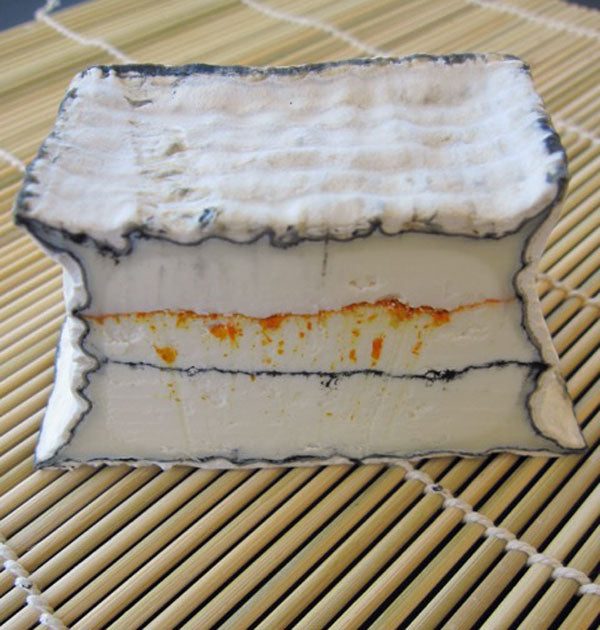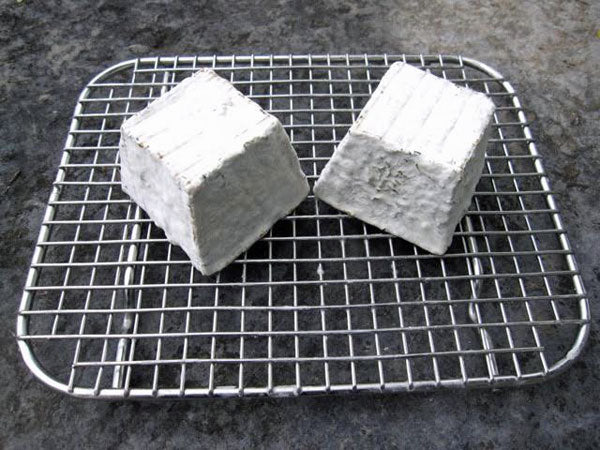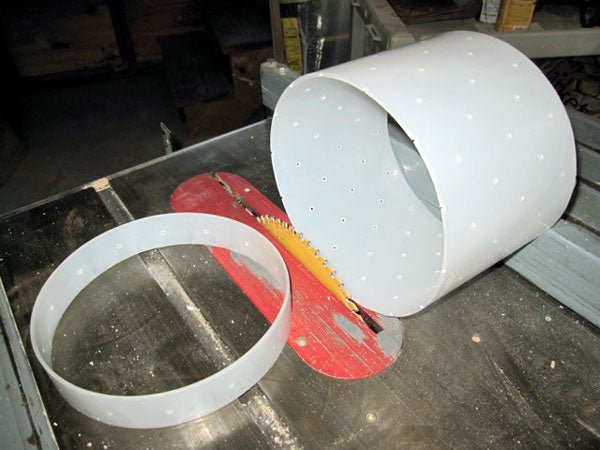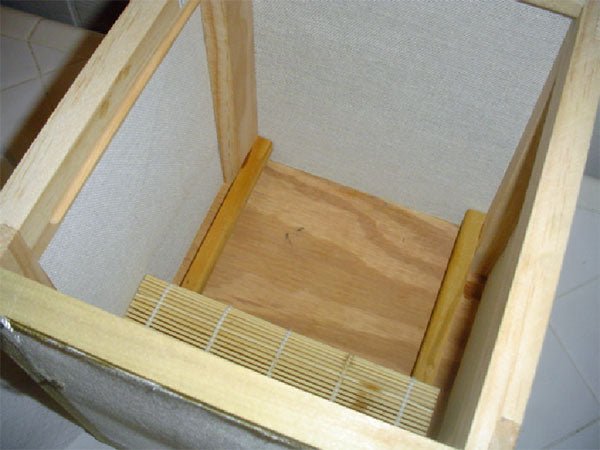This is gorgeous! The intense colors of wildflowers against the bright white of the goat cheese make this cheese spectacular. If you believe, as I do, that beauty enhances taste, this could be the next step you take with your homemade goat cheese.
1. Wildflowers in Your Cheese
Terry Dinnan, a home cheese maker in Charlotte, Vermont is using powdered wildflowers (along with ash) to create horizontal bands of color in his cheese. (We recently posted another of Terry’s great ideas – Modifying Molds and he will be our “Spotlight” in the October Moos-Letter.)

Calendula petals and ash

Bee balm (Bergamot) and sage
He grows or picks edible flower petals, dries them on stainless screens using the pilot light heat in his gas stove oven, and grinds them in a coffee bean grinder if necessary.

Flax flower petals drying
He told us, “The availability of colors is amazing. Purple loosestrife, for instance, is an invasive nuisance plant. It is edible, however, and has been used as a medicinal. It’s flowers dry to a vivid purple which I’m currently trying out. Some flowers (i.e. batchelor buttons) dry beautifully but wash out when embedded in cheese. I’m experimenting with a rainbow of colors.”

How he got started:
Last year I tasted some ash-coated chèvre at a party and was impressed with how flavorful it was for a young cheese. I started to get some extra goat milk from the maker and started making it myself. He stopped milking his goats but knew of a couple in the area who were milking, so I spoke to them. They had extra raw milk but said they weren’t allowed to sell to the public. I proposed that I buy a “share” in one of their goats so that I’d be technically using my own milk. They were comfortable with that and I’m picking up 5 gallons a month. I’m only using the flower powder on goat cheese that is not too creamy. I don’t think it would be a good fit for softer cheeses such as camembert or brie.
His method:
Lines through the inside:
I hang the curds until the dripping slows (time varies a lot from batch to batch), but stop hanging when the curd is still soft enough to conform well to the mold. The flower layer(s) are added when the mold is filled and then some slow draining continues overnight. The next day, the cheese can be released from the mold (although still fragile) and surfaced with charcoal and salt.
Usually, the next day, I move it to our cooler basement, close in a screened milk crate (protection from flies, etc.), and turn on a small fan (tiny muffin-cooling fan that is quiet and gentle) to move air (through the screening) a bit to encourage drying. The white rind develops in a few days and I then move it to a wine cooler at about 55f and 80% humidity. After 2-3 weeks, its ready for fresh eating or freezing for later. It freezes pretty well.

Adding flower petal layer in pyramid molds (ash-coated chèvre)…from top left: dahlia, rose, purple loosestrife, marigold/ash
Color on the outside:
I make little piles of the flowers/herbs mixed with the salt (on a stainless cookie sheet) and pat them on by hand. Because the cheese is still moist, your fingers get damp and pick up the salt and powders very easily for surfacing. This is the 1st time I’ve tried them on the surface so I don’t have much of a system. I’m just doing it the same way I apply charcoal and salt. The white rind molds seemed to have no problem growing over the coated surfaces.


Cheeses coated 8/16

Same cheeses 6 days later on 8/22
I grow some of our flowers (batchelor buttons, calendula, marigolds, bee balm, nasturtiums, etc.) and collect some. We grow organically and, when I collect in the wild, I stay away from roadside flowers or areas that may have been sprayed. Its important to know where flowers come from so I would caution people to never eat anything from big box distributors or unknown sources. Organic only!
About taste:
Most of the dried flowers are quite bland and the amount used often isn’t a taste consideration. Some do offer floral notes (i.e. rose) and some are slightly spicy (bee balm, marigold). The most noticeable flavor changers are generally stronger herbs. Green stripes of freshly dried homegrown organic sage are very noticeable and, I think, a great companion to the chèvre flavor. I would think other herbs (paprika, saffron, etc.) could make some nice combos. I like to experiment so this is really a work in progress that will hopefully result in some favorite color/taste favorites.

Update: Terry had been experimenting with using sage instead of ash in the middle of his cheeses, and the results were excellent.
2. Wildflowers on Your Cheese
There is a rich tradition of coating the outsides of cheeses in dried wildflowers. One of the most famous is Caprino Fiorito, a flavored goat cheese from the Piedmont region of Italy (available at Whole Foods):

Photo courtesy of Cheesemongers of Santa Fe
Another example is the Tomme aux Fleurs Sauvages d’Alpage, available in France only, as far as we can tell:

There is also a goat farm in Pescadero, California, Harley Farms, where they grow their own wildflowers to decorate the outside of their goat cheeses. The results are amazing!

A tour at Harley Farms

Harley Farms cheeses ready for sale

Courtesy of Gastronomichael. Harley Farm’s (Monet) won first place in the Open Farmstead cheese category at the 2008 ACS Competition.
Of course, when using wildflowers, it is important to follow the rules of hygiene. Here are a few suggestions we found at Design Sponge:
The Ten Rules of Edible Flowers
1. Eat flowers only when you are positive they are edible.
2. Just because it is served with food does not mean a flower is edible (see Rule 1).
3. Eat only flowers that have been grown organically.
4. Do not eat flowers from florists, nurseries or garden centers (see Rule 3).
5. If you have hay fever, asthma or allergies, do not eat flowers.
6. Do not eat flowers picked from the side of the road. They are contaminated from car emissions (see Rule 3).
7. Remove pistils and stamens from flowers before eating. Eat only the petals.
8. Not all flowers are edible. Some are poisonous.
9. There are many varieties of any one flower. Flowers taste different when grown in different locations.
10. Introduce flowers to your diet the way you would new foods to a baby — one at a time in small quantities.












































































































































